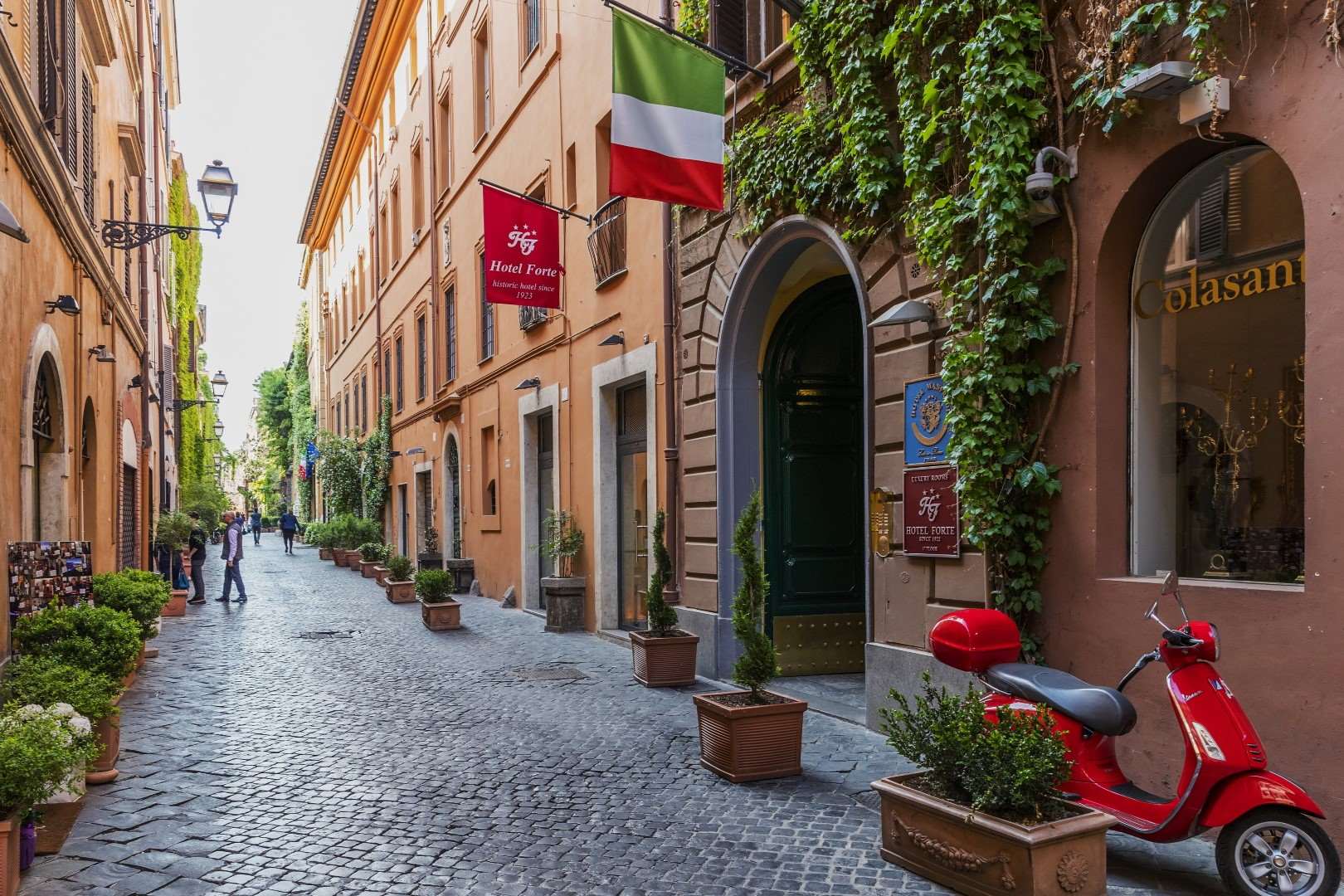
Via Margutta is a charming street in Rome, Italy, known for its artistic flair and rich history. But what makes this cobblestone lane so special? It's famous for its connection to artists, filmmakers, and even a few celebrities. Nestled between the Spanish Steps and Piazza del Popolo, Via Margutta has been a haven for painters, sculptors, and creatives for centuries. Did you know that Federico Fellini, the legendary filmmaker, once called this street home? Or that it was featured in the classic film "Roman Holiday"? From art galleries to quaint cafes, Via Margutta offers a unique blend of culture and history. Whether you're an art lover or a history buff, this street has something to pique your interest. Ready to learn more? Let's dive into 35 fascinating facts about Via Margutta!
Key Takeaways:
- Via Margutta, a historic street in Rome, has been a haven for artists, celebrities, and history enthusiasts. Its rich cultural heritage, artistic legacy, and charming atmosphere continue to captivate visitors from around the world.
- From ancient origins to modern-day appeal, Via Margutta's blend of history, art, and tranquility makes it a must-visit destination in Rome. Its architectural marvels, celebrity connections, and cultural impact offer a unique and timeless experience for all.
Via Margutta: A Hidden Gem in Rome
Via Margutta, a charming street in Rome, has a rich history and unique character. Nestled between Piazza del Popolo and Piazza di Spagna, this street has been a haven for artists, celebrities, and history enthusiasts. Let's dive into some fascinating facts about Via Margutta.
Historical Significance
This street has witnessed centuries of history, making it a significant part of Rome's cultural heritage.
- Ancient Origins: Via Margutta dates back to ancient Rome, originally serving as a service road for the nearby villas.
- Name Origin: The name "Margutta" is believed to come from the Latin word "Marisgutta," meaning "drop of the sea," reflecting its proximity to the Tiber River.
- Medieval Transformation: During the Middle Ages, the street transformed into a hub for artisans and craftsmen.
- Renaissance Revival: In the Renaissance, Via Margutta became a popular location for artists' studios and workshops.
- Baroque Influence: The Baroque period saw the construction of many elegant buildings along the street, adding to its charm.
Artistic Legacy
Via Margutta has long been associated with the art world, attracting painters, sculptors, and other creatives.
- Artists' Colony: In the 17th century, it became an artists' colony, with many famous painters setting up studios here.
- Federico Fellini: The renowned Italian filmmaker Federico Fellini lived on Via Margutta for many years.
- Pablo Picasso: Picasso stayed on this street during his visits to Rome, drawing inspiration from its vibrant atmosphere.
- Art Galleries: Today, Via Margutta is home to numerous art galleries showcasing contemporary and classic works.
- Annual Art Fair: The street hosts an annual art fair, attracting artists and collectors from around the world.
Celebrity Connections
Over the years, Via Margutta has been a magnet for celebrities, adding to its allure.
- Audrey Hepburn: Audrey Hepburn's character lived on Via Margutta in the classic film "Roman Holiday."
- Gregory Peck: Gregory Peck, Hepburn's co-star in "Roman Holiday," also filmed scenes on this iconic street.
- Sophia Loren: The legendary actress Sophia Loren once resided on Via Margutta.
- Jean Cocteau: French writer and filmmaker Jean Cocteau was another famous resident.
- Modern Celebrities: Today, the street continues to attract celebrities looking for a quiet, picturesque retreat.
Architectural Marvels
The architecture of Via Margutta is a blend of different styles, reflecting its long history.
- Elegant Facades: The street is lined with elegant facades, many adorned with ivy and flowers.
- Historic Buildings: Several buildings date back to the Renaissance and Baroque periods.
- Art Nouveau Influence: Some structures feature Art Nouveau elements, adding to the eclectic mix.
- Hidden Courtyards: Many buildings have hidden courtyards, offering a peaceful escape from the bustling city.
- Charming Details: Look closely, and you'll find charming architectural details like wrought-iron balconies and ornate doorways.
Cultural Impact
Via Margutta has left a lasting impact on Rome's cultural landscape.
- Literary References: The street has been mentioned in numerous literary works, highlighting its cultural significance.
- Film Location: Besides "Roman Holiday," Via Margutta has been featured in several other films and TV shows.
- Music Inspiration: Musicians have also found inspiration here, with some even composing songs about the street.
- Cultural Events: The street hosts various cultural events throughout the year, celebrating its artistic heritage.
- Museums Nearby: Several museums are located nearby, offering further insights into Rome's rich history and culture.
Modern-Day Appeal
Despite its historical roots, Via Margutta remains relevant and appealing in modern times.
- Boutique Shops: The street is home to a variety of boutique shops, offering unique and high-quality products.
- Cafes and Restaurants: Quaint cafes and restaurants line the street, providing perfect spots for a leisurely meal or coffee.
- Peaceful Atmosphere: Despite being in the heart of Rome, Via Margutta maintains a peaceful and serene atmosphere.
- Art Studios: Many artists still have studios here, continuing the street's artistic legacy.
- Tourist Attraction: Via Margutta has become a popular tourist attraction, drawing visitors from around the globe.
Interesting Tidbits
Here are some lesser-known facts that add to the charm of Via Margutta.
- Secret Passages: The street has several secret passages that were once used by artists to move between studios unnoticed.
- Famous Neighbors: Via Margutta is located near other famous streets like Via del Babuino and Via dei Condotti.
- Historical Plaques: Numerous plaques along the street commemorate its famous residents and historical events.
- Art Schools: Several art schools are located nearby, nurturing the next generation of artists.
- Timeless Beauty: Despite changes over the centuries, Via Margutta has retained its timeless beauty and charm.
The Charm of Via Margutta
Via Margutta, a quaint street in Rome, holds a treasure trove of history and artistic charm. From its humble beginnings as a street for artisans to becoming a haven for famous artists and celebrities, it has seen it all. Federico Fellini, Pablo Picasso, and Audrey Hepburn are just a few names linked to this enchanting place. The street's unique blend of art studios, galleries, and historic buildings makes it a must-visit for anyone interested in culture and history.
Whether you're an art enthusiast, a history buff, or just someone who loves exploring hidden gems, Via Margutta offers something special. Its cobblestone paths and ivy-covered walls invite you to take a stroll and soak in the atmosphere. So next time you're in Rome, don't miss the chance to experience the timeless allure of Via Margutta.
Frequently Asked Questions
Was this page helpful?
Our commitment to delivering trustworthy and engaging content is at the heart of what we do. Each fact on our site is contributed by real users like you, bringing a wealth of diverse insights and information. To ensure the highest standards of accuracy and reliability, our dedicated editors meticulously review each submission. This process guarantees that the facts we share are not only fascinating but also credible. Trust in our commitment to quality and authenticity as you explore and learn with us.


